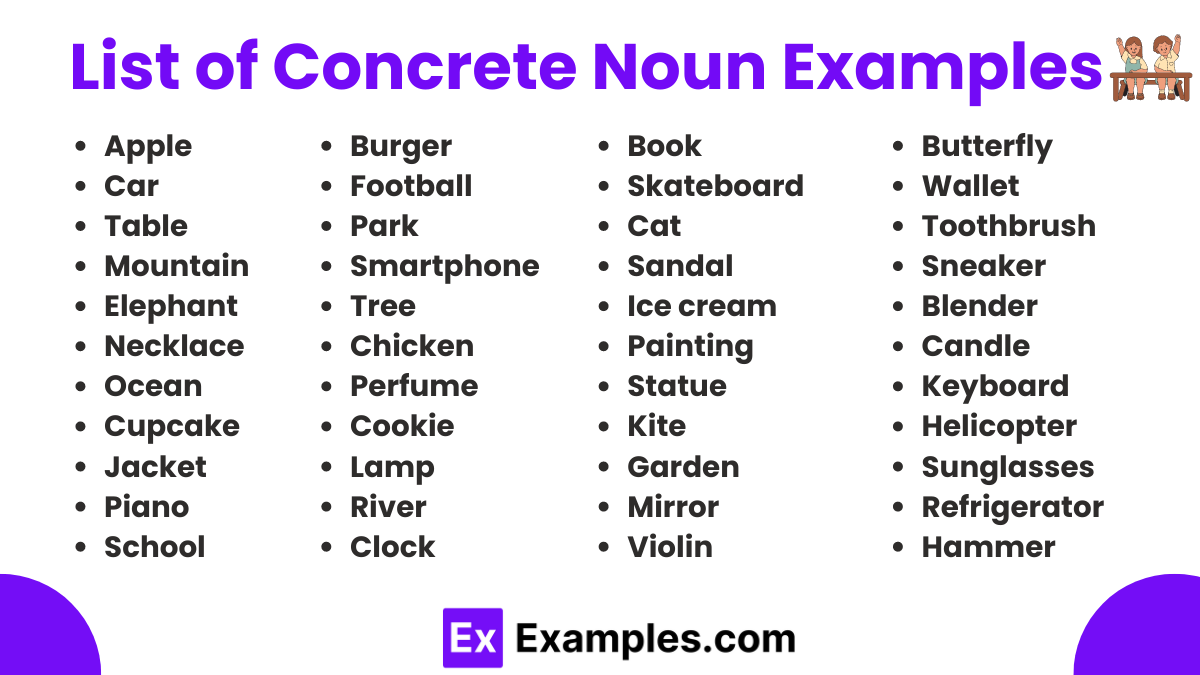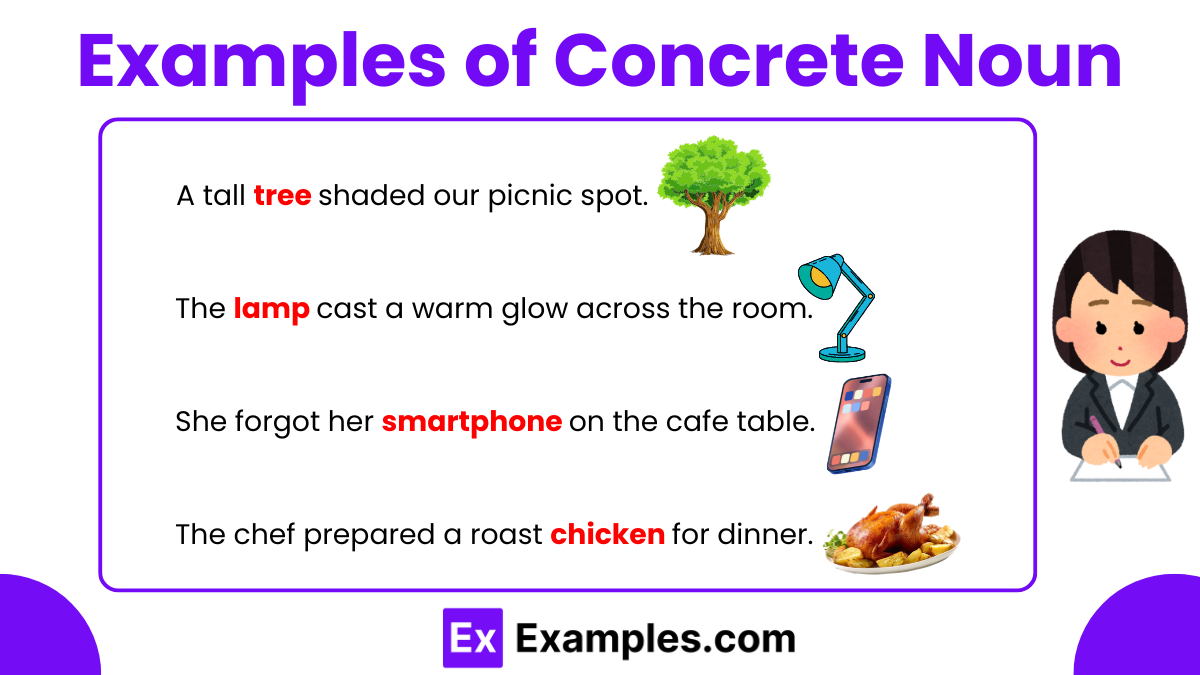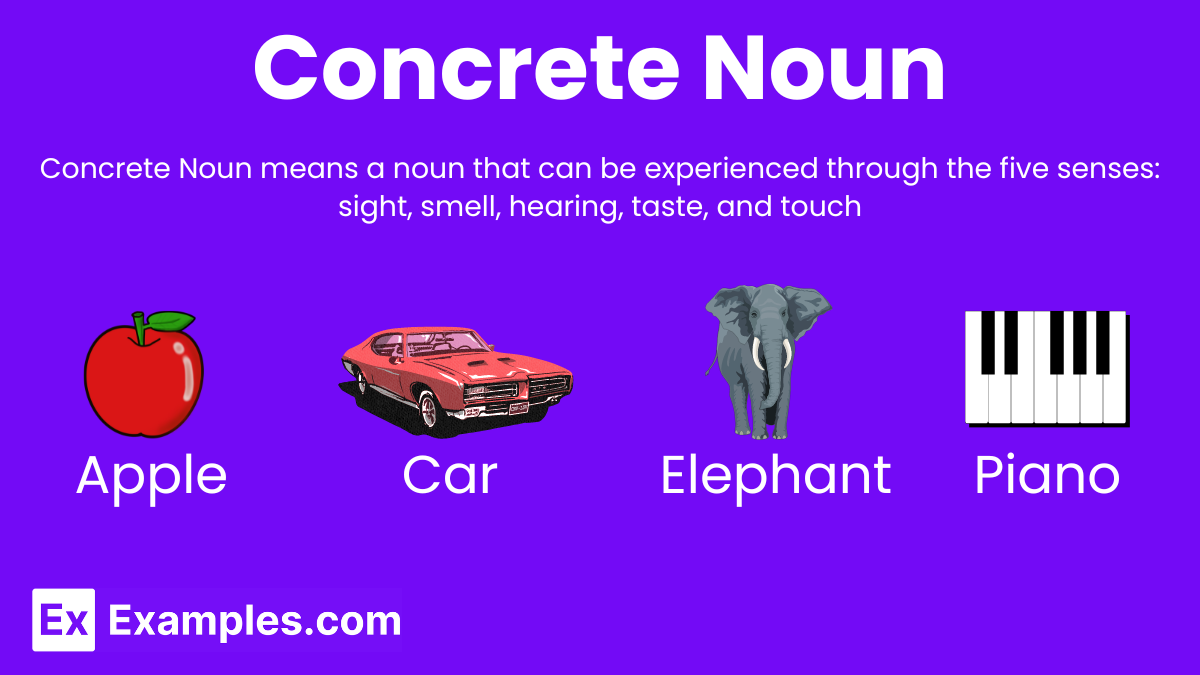50+ Concrete Noun Examples
A concrete noun refers to something that you can experience through your senses; you can see, touch, smell, hear, or taste it. Common examples include “cat,” “chocolate,” and “music.” In English grammar, understanding concrete nouns is essential because they allow us to identify and describe physical objects in our surroundings. This knowledge is foundational in learning how nouns function as key components of language, helping us to communicate more effectively and vividly.
What is Concrete Noun?
Types of Concrete Noun
- Common Nouns: These are general names for things, without specifying a unique identity. Examples include “city,” “animal,” or “book.” They refer to general items rather than specific ones and are usually not capitalized unless they start a sentence.
- Proper Nouns: These refer to specific names of people, places, or organizations and are always capitalized. Examples include “London,” “Julia,” or “Microsoft.” Proper nouns pinpoint exact entities, distinguishing them from others of the same type.
- Countable Nouns: These nouns can be counted as individual units and have both singular and plural forms. For example, “car” can become “cars,” and “apple” can turn into “apples.” They allow for precise quantification in speech and writing.
- Uncountable Nouns: Also known as mass nouns, these refer to substances or concepts that cannot be counted with numbers and do not have a plural form. Examples include “milk,” “sand,” and “happiness.” They often require quantifiers like “some” or “a lot of” when being described.
- Collective Nouns: These nouns represent groups of people, animals, or things. A single term like “team,” “flock,” or “bunch” can encapsulate multiple individuals or items as a whole. Collective nouns are singular in form but are understood as referring to more than one entity.
List of Concrete Noun Examples

- Apple
- Car
- Table
- Mountain
- Elephant
- Necklace
- Ocean
- Cupcake
- Jacket
- Piano
- School
- Burger
- Football
- Park
- Smartphone
- Tree
- Chicken
- Perfume
- Cookie
- Lamp
- River
- Book
- Skateboard
- Cat
- Sandal
- Ice cream
- Painting
- Statue
- Kite
- Garden
- Mirror
- Clock
- Violin
- Butterfly
- Wallet
- Toothbrush
- Sneaker
- Blender
- Candle
- Keyboard
- Helicopter
- Sunglasses
- Refrigerator
- Hammer
- Notebook
- Sailboat
- Bracelet
- Towel
- Printer
- Backpack
- Pillow
- Umbrella
Examples of Concrete Noun in a Sentences

- She sliced the apple into quarters and added them to the salad.
- The car was parked just outside the building, sparkling under the streetlight.
- We gathered around the table to celebrate his birthday.
- The mountain loomed large against the clear blue sky.
- A young elephant played in the water while its family watched nearby.
- She wore a beautiful necklace that glittered in the evening light.
- Waves crashed against the shore of the vast ocean.
- The cupcake was topped with pink frosting and a cherry.
- He put on his jacket as the evening grew colder.
- The piano in the corner of the room was a beautiful antique.
- Children were playing in the school playground.
- For lunch, I had a juicy burger with fries.
- He kicked the football across the field to his teammate.
- They met at the park to walk their dogs.
- She forgot her smartphone on the cafe table.
- A tall tree shaded our picnic spot.
- The chef prepared a roast chicken for dinner.
- The room was filled with the sweet scent of her perfume.
- The cookie jar was nearly empty by the end of the day.
- The lamp cast a warm glow across the room.
Examples of Concrete Noun for Kids
- Dog – A pet that barks and wags its tail.
- Cookie – A sweet treat you can eat as a snack.
- Ball – Something round you can throw, catch, or kick.
- Car – A vehicle with wheels that takes you places.
- Tree – A tall plant that has a trunk and leaves.
- Book – Something you read to learn stories or get information.
- Chair – A piece of furniture you sit on.
- Shoe – What you wear on your feet to protect them.
- Cat – A pet that purrs and likes to nap.
- Bed – A piece of furniture where you sleep at night.
Concrete Noun and Abstract Noun
| Aspect | Concrete Noun | Abstract Noun |
|---|---|---|
| Definition | Names a thing that can be perceived with the senses (sight, touch, smell, hearing, taste). | Names an idea, quality, or state that cannot be perceived with the senses. |
| Tangibility | Tangible, meaning they refer to objects that physically exist and can be observed. | Intangible, referring to concepts or qualities that do not have a physical form. |
| Examples | Apple, car, mountain, book, elephant. | Love, freedom, intelligence, happiness, bravery. |
| Usage in Speech | Often used to describe physical actions or attributes. | Often used to discuss emotions, theories, conditions, or other concepts that are not physical. |
| Quantification | Can be counted or measured (e.g., three dogs, a slice of pizza). | Cannot be quantified; does not have a plural form (e.g., “sufferings” is incorrect). |
How to Use Concrete Noun
Concrete nouns are invaluable in language as they name objects, people, and places that can be detected by the senses
Identify the Physical Object
When you want to be specific about an item or person in your writing or speech, use a concrete noun to name it directly. This clarifies what you are referring to and helps the listener or reader visualize your message.
Enhance Descriptive Writing
Concrete nouns are essential for creating vivid descriptions in narratives. By naming specific items, such as a “silver watch” or a “creaking door,” you craft a mental image that engages your audience more deeply.
Aid in Learning for Young Audiences
When teaching children or individuals learning a new language, concrete nouns are particularly useful because they refer to things that can be seen or touched, making them easier to comprehend and memorize.
Support Clear Communication
Employing concrete nouns helps eliminate ambiguity, ensuring that your audience knows exactly what you are talking about. This clarity is crucial in both written and spoken communication.
Combine with Adjectives
To provide richer details and enhance the listener’s or reader’s experience, pair concrete nouns with descriptive adjectives. This enriches your descriptions and makes your content more dynamic and interesting.
Tips for Using Concrete Noun
- Be Specific: Choose concrete nouns that clearly define what you’re describing. Opt for “motorcycle” over “vehicle” for a clearer image.
- Add Sensory Details: Enhance concrete nouns with sensory adjectives to enrich your descriptions, like describing a “crisp, red apple.”
- Combine with Abstract Nouns: Pair concrete nouns with abstract ones to add depth to your narrative, such as a “rusty lock” on a diary full of “secrets.”
- Use Vivid Language: Opt for vivid and engaging descriptions, like “towering Great Dane” instead of “big dog.”
- Aid in Education: Use concrete nouns to help learners visualize concepts, making lessons more relatable and easier to grasp
Is name a concrete noun?
No, name is not a concrete noun because it represents a virtual entity that cannot be seen, touched, heard, smelled, or tasted.
Are all nouns concrete?
No, nouns can also be abstract, which represent ideas, qualities, or states that cannot be seen or touched, like “happiness” or “strength.”
How do I identify a concrete noun?
If you can see, touch, smell, hear, or taste the item, it is a concrete noun.
Why are concrete nouns important in writing?
They help create vivid descriptions that allow the reader to clearly visualize what is being communicated.
Can a concrete noun also be a proper noun?
Yes, a concrete noun can be a proper noun if it names a specific item, like “Eiffel Tower” or “London.”
Do concrete nouns have genders?
In English, concrete nouns do not have gender, unlike in some other languages where nouns are gendered.
Can concrete nouns be plural?
Yes, concrete nouns can have both singular and plural forms, such as “cat” and “cats.”
Is ‘water’ a concrete noun?
Yes, “water” is a concrete noun because it can be seen, tasted, and touched.
Can a place be a concrete noun?
Yes, places like “park” or “London” are concrete nouns because they are physical locations.
Are vehicles considered concrete nouns?
Yes, vehicles like “bicycle” or “airplane” are concrete nouns due to their tangibility.



